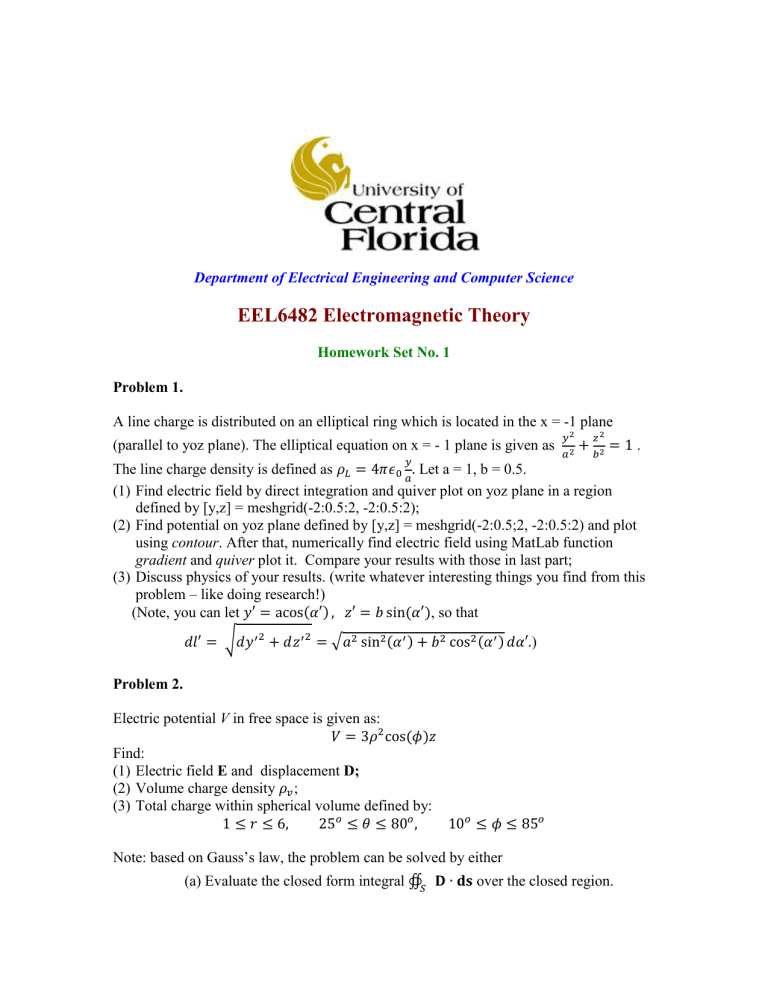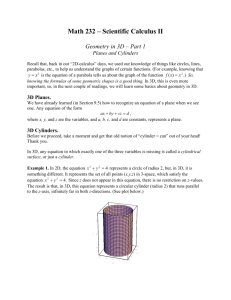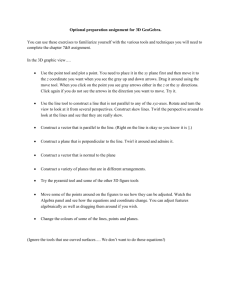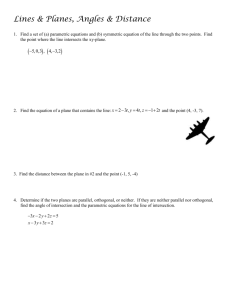hw1 - Department of Electrical Engineering and Computer

Department of Electrical Engineering and Computer Science
EEL6482 Electromagnetic Theory
Homework Set No. 1
Problem 1.
A line charge is distributed on an elliptical ring which is located in the x = -1 plane
(parallel to yoz plane). The elliptical equation on x = - 1 plane is given as 𝑦 𝑎 𝑦
2
2
+ 𝑧
2 𝑏 2
= 1
The line charge density is defined as 𝜌
𝐿
= 4𝜋𝜖
0
.
Let a = 1, b = 0.5. 𝑎
(1) Find electric field by direct integration and quiver plot on yoz plane in a region defined by [y,z] = meshgrid(-2:0.5:2, -2:0.5:2);
.
(2) Find potential on yoz plane defined by [y,z] = meshgrid(-2:0.5;2, -2:0.5:2) and plot using contour . After that, numerically find electric field using MatLab function gradient and quiver plot it. Compare your results with those in last part;
(3) Discuss physics of your results. (write whatever interesting things you find from this problem – like doing research!)
(Note, you can let 𝑦′ = acos(𝛼′) , 𝑧′ = 𝑏 sin(𝛼′) , so that 𝑑𝑙′ = √𝑑𝑦 ′2 + 𝑑𝑧 ′2 = √𝑎 2 sin 2 (𝛼 ′ ) + 𝑏 2 cos 2 (𝛼 ′ ) 𝑑𝛼′.
)
Problem 2.
Electric potential V in free space is given as:
𝑉 = 3𝜌 2 cos (𝜙)𝑧
Find:
(1) Electric field E and displacement D;
(2) Volume charge density 𝜌 𝑣
;
(3) Total charge within spherical volume defined by:
1 ≤ 𝑟 ≤ 6, 25 𝑜 ≤ 𝜃 ≤ 80 𝑜 , 10 𝑜 ≤ 𝜙 ≤ 85
Note: based on Gauss’s law, the problem can be solved by either 𝑜
(a) Evaluate the closed form integral ∯ 𝐃 ∙ 𝐝𝐬 over the closed region.
(b) Calculate using ∭
𝑉𝑜𝑙 𝜌 𝑣 𝑑𝑣 .
Problem 3.
A parallel plate capacitor is filled with a nonuniform dielectric characterized by
r
2
2 z
, where z is the distance from bottom plate. If the area of each plate S and the separation between the two plates is d , find the potential distribution between two plates and calculate capacitance C . Assume the bottom plate at z
0
has 0 potential and the top plate at z
d has potential
V
0
. Neglect fringing effects.
Problem 4.
For two dimensional potential problem (
z
0
) defined in 0
x
a
and
0
y
assume potential V = 0 for y = 0, y = b and x = 0 planes, and V = f ( y ) at x = a . b
,
(1) If f ( y ) = 5y/b V, find the potential distribution V ( x, y ) within the solution domain, plot
V ( 0.25a, y ) , V ( 0.5a, y ) and V ( 0.75a, y ) versus y/b using Matlab.
(2) If f ( y ) = 5 V (constant), do last part.
Problem 5.
For three dimensional potential problem defined in 0
x
a , 0
y
b , and 0
z
, assume potential V=0 for x=0, a ; and y=0, b planes. For z=0 plane, V=f(x,y) . Assume
V=0 when z tends to be
.
(1) If 𝑓(𝑥, 𝑦) = sin (𝑥)cos (𝑦) , find potential distribution V ( x,y,z ) and the electric field distribution E ( x,y,z ).
(2) If 𝑓(𝑥, 𝑦) = 1 (𝑐𝑜𝑛𝑠𝑡) and a = b = 1 meter, plot potential distribution versus x and y for z = 0.1 m using Matlab 3-D plot.
Problem 6.
For three dimensional potential problem defined in 0 assume
V
x
0 for x=0, a planes; and
For z=0 plane, 𝑉(𝑥, 𝑦) = 𝑥 2 + 𝑦 2
V y
0 for
x
y=0, b a , 0
y
planes. For
. Find potential distribution V ( x,y,z b
,
and z=h
0
plane, z
V
h
=0.
,
) within the solution domain and then find the electric field distribution E ( x,y,z ).









